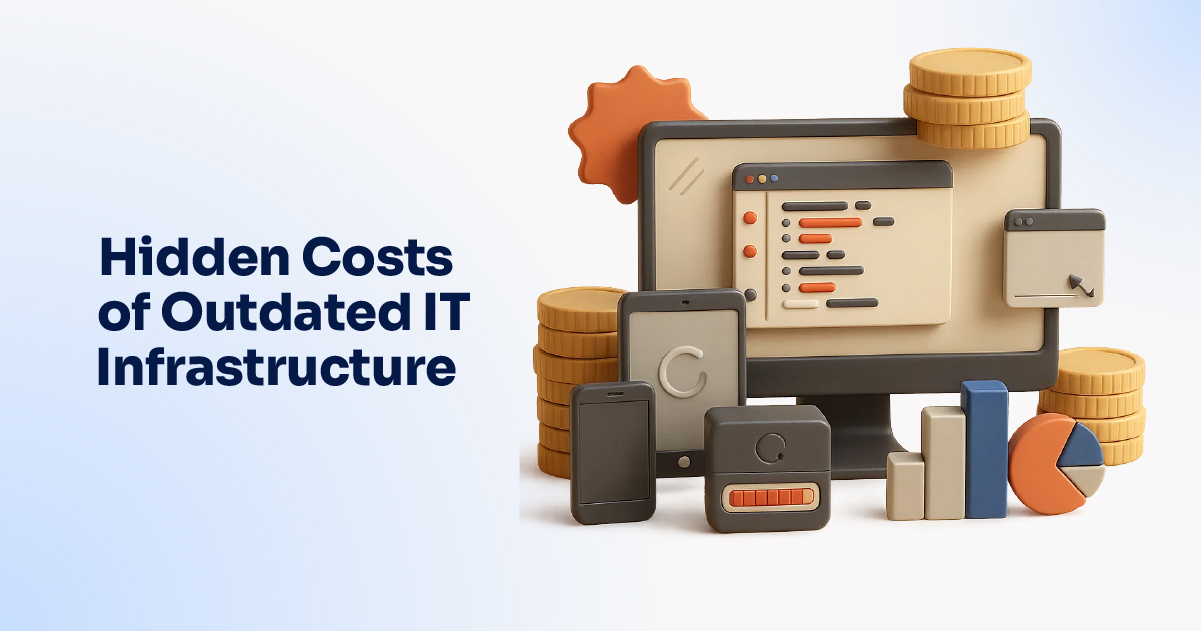
In today’s fast-paced digital world, technology is the backbone of every successful business. But what happens when the backbone starts to crack? If your company is still relying on outdated IT infrastructure, you’re not just missing out on the latest innovations—you’re incurring hidden costs that could be silently eroding your profits and productivity.
While upgrading infrastructure may seem like a major investment, the cost of doing nothing is often far greater. From reduced efficiency to increased security risks, outdated systems can hinder your growth and leave your business vulnerable. Let’s explore the hidden costs of legacy infrastructure and why it’s time to consider cloud migration.
1. Decreased Productivity and Efficiency
Older systems often struggle to keep up with modern demands. Legacy infrastructure can lead to slower load times, frequent system crashes, and poor performance of business-critical applications. Employees waste valuable time troubleshooting outdated software or waiting for systems to respond.
This drop in productivity may seem minor on a day-to-day basis, but over time, it translates into a significant loss of operational efficiency—and ultimately, revenue.
2. Higher Maintenance Costs
Outdated hardware and software often require frequent repairs, updates, and patches to keep them functioning. As technology ages, finding replacement parts and support becomes more difficult and expensive.
Instead of investing in innovation, businesses often pour money into “keeping the lights on.” IT teams spend hours maintaining legacy systems rather than focusing on strategic initiatives that could drive growth. These ongoing maintenance costs can quietly drain your budget.
3. Limited Scalability and Flexibility
Modern businesses must be agile to stay competitive. Legacy infrastructure, however, often lacks the flexibility to scale with changing needs. Whether you’re expanding your team, launching new services, or entering new markets, outdated systems can slow you down.
Cloud solutions, by contrast, offer near-instant scalability. You can increase or decrease resources based on demand—without investing in physical hardware or facing lengthy deployment times.
4. Increased Security Risks
Cybersecurity is a critical concern for businesses of all sizes. Older systems may no longer receive security updates, making them prime targets for hackers. Legacy infrastructure often lacks support for modern security features like multi-factor authentication or advanced threat detection.
Data breaches not only result in regulatory fines and legal fees, but they also damage your reputation and erode customer trust. In fact, small and mid-sized businesses are increasingly targeted by cybercriminals due to their weaker defenses.
Migrating to modern cloud platforms ensures that your infrastructure is protected by the latest security protocols and monitored 24/7 by dedicated experts.
5. Compliance Challenges
As data protection laws like GDPR and CCPA become stricter, businesses must ensure their systems comply with evolving regulations. Outdated infrastructure may not support the latest compliance standards, putting you at risk of violations.
Cloud platforms are designed to help businesses stay compliant by offering built-in tools, data governance frameworks, and regular audits. By migrating, you not only modernize your technology but also gain peace of mind when it comes to regulatory requirements.
6. Lost Competitive Edge
Technology is a major differentiator in today’s market. Companies that adopt modern tools and processes can respond more quickly to customer needs, launch new products faster, and deliver better digital experiences.
- Relying on outdated infrastructure means falling behind competitors who are already leveraging cloud-based solutions, automation, and AI. Customers today expect speed, reliability, and innovation—qualities that legacy systems simply cannot deliver.
Why You Should Migrate Now
The risks and hidden costs of outdated infrastructure are too significant to ignore. Migrating to the cloud is no longer optional—it’s a strategic move that can transform your business.
Here’s what you gain from a cloud migration:
- Cost savings from reduced hardware, maintenance, and energy expenses
- Enhanced security with continuous monitoring and regular updates
- Increased agility to scale resources on-demand
- Improved collaboration through integrated tools and remote access
- Access to innovation with the latest AI, analytics, and automation tools
The migration process may seem daunting, but with the right partner, it can be seamless and hassle-free. Investing in professional Cloud Migration Services ensures that your transition is smooth, secure, and tailored to your specific business needs.
Choosing the Right Partner
Not all migration services are created equal. Look for a provider with proven experience, a clear migration roadmap, and a deep understanding of both your current environment and your future goals.
Exinent’s Cloud Migration Services are designed to help businesses of all sizes modernize their infrastructure with minimal disruption. From assessment to execution, our team guides you every step of the way—ensuring business continuity, data integrity, and post-migration support.
Conclusion
Outdated infrastructure is more than just an inconvenience—it’s a liability. The hidden costs of
inefficiency, security risks, and lost opportunities can add up quickly. Migrating to the cloud not only addresses these issues but also positions your business for long-term success.
Now is the time to act. Don’t let outdated technology hold you back. Embrace the future with a smarter, faster, and more secure IT environment.
Ready to make the move? Talk to the experts at Exinent and start your migration journey today.
